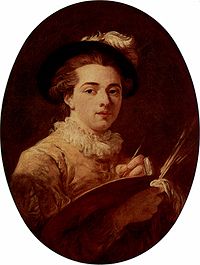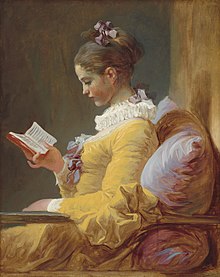Jean-Honoré Fragonard
Jean-Honoré Fragonard | |
|---|---|
 From a Self-portrait in the Musée Fragonard | |
| Born | Jean-Honoré Nicolas Fragonard[1] 5 April 1732 |
| Died | 22 August 1806 (aged 74) |
| Nationality | French |
| Education | Chardin, Boucher, French Academy in Rome, Charles-André van Loo |
| Known for | painting, drawing, etching |
| Notable work | The Swing, A Young Girl Reading, The Bolt |
| Movement | rococo |
| Awards | Prix de Rome |
Jean-Honoré Fragonard (French pronunciation: [ʒã onoʀe fʀaɡoˈnɑʀ]; 5 April 1732[2] – 22 August 1806) was a French painter and printmaker whose late Rococo manner was distinguished by remarkable facility, exuberance, and hedonism. One of the most prolific artists active in the last decades of the Ancien Régime, Fragonard produced more than 550 paintings (not counting drawings and etchings), of which only five are dated. Among his most popular works are genre paintings conveying an atmosphere of intimacy and veiled eroticism.
Biography


Jean-Honoré Fragonard was born at Grasse, Alpes-Maritimes, the son of François Fragonard, a glover, and Françoise Petit.[1] He was articled to a Paris notary when his father's circumstances became strained through unsuccessful speculations, but showed such talent and inclination for art that he was taken at the age of eighteen to François Boucher, who, recognizing the youth's rare gifts but disinclined to waste his time with one so inexperienced, sent him to Chardin's atelier. Fragonard studied for six months under the great luminist, then returned more fully equipped to Boucher, whose style he soon acquired so completely that the master entrusted him with the execution of replicas of his paintings. Though not yet a pupil of the Academy, Fragonard gained the Prix de Rome in 1752 with a painting of "Jeroboam Sacrificing to the Golden Calf", but before proceeding to Rome he continued to study for three years under Charles-André van Loo. In the year preceding his departure he painted the "Christ washing the Feet of the Apostles" now at Grasse cathedral. On 17 September 1756, he took up his abode at the French Academy in Rome, then presided over by Charles-Joseph Natoire.
While at Rome, Fragonard contracted a friendship with a fellow painter, Hubert Robert. In 1760, they toured Italy together, executing numerous sketches of local scenery. It was in these romantic gardens, with their fountains, grottos, temples and terraces, that Fragonard conceived the dreams which he was subsequently to render in his art. He also learned to admire the masters of the Dutch and Flemish schools (Rubens, Hals, Rembrandt, Ruisdael), imitating their loose and vigorous brushstrokes. Added to this influence was the deep impression made upon his mind by the florid sumptuousness of Giovanni Battista Tiepolo, whose works he had an opportunity to study in Venice before he returned to Paris in 1761.
In 1765, his "Coresus et Callirhoe" secured his admission to the Academy. It was made the subject of a pompous (though not wholly serious) eulogy by Diderot, and was bought by the king, who had it reproduced at the Gobelins factory. Hitherto Fragonard had hesitated between religious, classic and other subjects; but now the demand of the wealthy art patrons of Louis XV's pleasure-loving and licentious court turned him definitely towards those scenes of love and voluptuousness with which his name will ever be associated, and which are only made acceptable by the tender beauty of his color and the virtuosity of his facile brushwork; such works include the Blind man's bluff,[3] Serment d'amour (Love Vow), Le Verrou (The Bolt), La Culbute (The Tumble), La Chemise enlevée (The Shirt Removed), and L'escarpolette (The Swing, Wallace Collection), and his decorations for the apartments of Mme du Barry and the dancer Madeleine Guimard.

A lukewarm response to these series of ambitious works induced Fragonard to abandon Rococo and to experiment with Neoclassicism. He married Marie-Anne Gérard, herself a painter of miniatures,[4] (1745–1823) on 17 June 1769 and had a daughter, Rosalie Fragonard (1769–1788), who became one of his favourite models. In October 1773, he again went to Italy with Pierre-Jacques Onézyme Bergeret de Grancourt and his son, Pierre-Jacques Bergeret de Grancourt. In September 1774, he returned through Vienna, Prague, Dresden, Frankfurt and Strasbourg.
Back in Paris, Marguerite Gérard, his wife's 14-year-old sister, became his pupil and assistant in 1778. In 1780, he had a son, Alexandre-Évariste Fragonard (1780–1850), who eventually became a talented painter and sculptor. The French Revolution deprived Fragonard of his private patrons: they were either guillotined or exiled. The neglected painter deemed it prudent to leave Paris in 1793 and found shelter in the house of his friend Maubert at Grasse, which he decorated with the series of decorative panels known as the Les progrès de l'amour dans le cœur d'une jeune fille,[5] originally painted for Château du Barry.
Jean-Honoré Fragonard returned to Paris early in the nineteenth century, where he died in 1806, almost completely forgotten.
Reputation
For half a century or more he was so completely ignored that Lübke in his History of Art (1873) omits the very mention of his name.[1] Subsequent reevaluation has confirmed his position among the all-time masters of French painting. The influence of Fragonard's handling of local colour and expressive, confident brushstroke on the Impressionists (particularly his grand niece, Berthe Morisot, and Renoir) cannot be overestimated. Fragonard's paintings, alongside those of François Boucher, seem to sum up an era.[6]
Gallery
- Gallery
-
The Lover Crowned, 1771-73, Frick Collection, New York
-
The Musical Contest, 1754-55, Wallace Collection, London
-
The Love Letter, 1770, Metropolitan Museum of Art, New York
-
The Stolen Kiss, late 1780s, Hermitage Museum, Saint Petersburg
Recent exhibitions
- Consuming Passion : Fragonard's Allegories of Love, Sterling and Francine Clark Art Institute, Williamstown, MA, from October 28, 2007 to January 21, 2008
- Fragonard , Jacquemart-André Museum, Paris, from October 3, 2007 to January 13, 2008
- Fragonard. Origines et influences. De Rembrandt au XXIe siècle, Barcelone, Caixa Forum From November 10, 2006 to February 11, 2007.
- Les Fragonard de Besançon, Musée des Beaux-Arts et d'archéologie de Besançon, from December 8, 2006 to April 2, 2007. Official website
- Jean-Honoré Fragonard, dessins du Louvre, Musée du Louvre, from December 3, 2003 to March 8, 2004.
Works
"As an illustrator his creative output took the form of drawing as often as painting."[4]
1750-1755
- Blindman's Bluff[3]
- c. 1750-1752
- oil on canvas, 46 x 36"[7]
- Located in the Toledo Museum of Art, Toledo, Ohio
- Young Woman Holding up Her Child
- c. 1750-1752
- oil on oval canvas, 18 1/2 x 12 5/8"[8]
- Located in the Musee de Louvre, Paris
- Venus and Cupid (aka Day)
- c. 1752-1753
- oil on canvas, 44 7/8 x 52 3/8"[9]
- Located in The National Gallery of Ireland, Dublin
- Jeroboam Sacrificing to Idols
- 1752
- oil on canvas, 45 1/4 x 57 1/8"[10]
- Located in Ecole Nationale Superieure des Beaux-arts, Paris
- Psyche Shows Her Sisters the Presents She Has Received From Cupid
- 1753-1752
- oil on canvas, 65 3/4 x 75 5/8"[11]
- Located in The National Gallery London, London
- Winter
- c. 1753-1756
- oil on canvas,31 1/2 x 64 1/2"[12]
- Located in Los Angeles County Museum of Art
- Diana and Endymion[13]
- c. 1753/1756
- oil on canvas, 94.9 x 136.8 cm
- Located in the National Gallery of Art
1760-1764
- Self-Portrait[14]
- c.1760
- Oil on canvas
- Musée-Villa Fragonard, Grasse, France.
1765-1770
- The painting was originally commissioned by a wealthy baron in homage to his beloved.
- 1767
- oil on canvas, 81 x 64.2 cm[16]
- Located in London in The Wallace Collection
- The Shirt Withdrawn[17]
- c. 1770
- Oil on canvas, 35 x 42 cm
- Musée du Louvre, Paris
See also
References
- ^ a b Houël de Chaulieu, Philippe (May 2006). "L'histoire en marche; Anniversaire: Jean-Honoré Fragonard". Intermédiaire des chercheurs & curieux — Issue 644. pp. 571–574. ISSN 0994-4532. Retrieved May 9, 2009.
- ^
Edmond and Jules de Goncourt (1881–1882). "Fragonard". L'Art du XVIIIe siècle. Vol. III. G. Charpentier. p. 241. ISBN 978-2-35548-008-9. Retrieved 2009-06-01.
Voici l'acte de naissance de Fragonard, dont M. Sénequier veut bien nous envoyer la copie prise par lui sur les registres conservés à la mairie de Grasse : «Année mille sept cent trente-deux. Le sixième avril, a été baptisé Jean-Honoré Fragonard, né le jour précédent, fils du sieur François, marchand, et de demoiselle Françoise Petit, son épouse ; le parrain : sieur Jean-Honoré Fragonard, son aïeul, et la marraine demoiselle Gabrielle Petit, sa tante, tous de cette paroisse. Signé qui a su : Fragonard, Fragonard, Martin, curé.»
{{cite book}}: line feed character in|quote=at position 156 (help) (birth/baptism certificate) - ^ a b Milam, Jennifer (1998). "Fragonard and the blindman's game: Interpreting representations of Blindman's Buff". Art History. 21 (1): 1–25. ISSN 0141-6790.
- ^ a b Ferrand, Franck (2008). "Monsieur Fragonard". France Today. 23 (2): 30–31. ISSN 0895-3651.
- ^ Also known as "Roman d'amour de la jeunesse".
- ^ http://www.ibiblio.org/wm/paint/auth/fragonard/
- ^ Massengale 1993, p.48
- ^ Massengale 1993, p.50
- ^ Massengale 1993, p.52
- ^ Massengale 1993, p.54
- ^ Massengale 1993, p.56
- ^ Massengale 1993, p.58
- ^ http://www.nga.gov/fcgi-bin/tinfo_f?object=46026
- ^ http://www.abcgallery.com/F/fragonard/fragonard.html
- ^ Milam, Jennifer (2000). "Playful Constructions and Fragonard's Swinging Scenes". Eighteenth-Century Studies. 33 (4): 543. ISSN 0013-2586.
- ^ Baur 2007, p.70
- ^ http://www.wga.hu/frames-e.html?/html/f/fragonar/index.html
Bibliography
- Books
- This article incorporates text from a publication now in the public domain: Chisholm, Hugh, ed. (1911). "Jean-Honore Fragonard". [[Encyclopædia Britannica Eleventh Edition|Encyclopædia Britannica]] (11th ed.). Cambridge University Press.
{{cite encyclopedia}}: URL–wikilink conflict (help) - Edmond and Jules de Goncourt (1881–1882). "Fragonard". L'Art du XVIIIe siècle. Vol. III. G. Charpentier. p. 241. ISBN 978-2-35548-008-9. Retrieved 2009-05-10.
- Eva-Gesine Baur (2007). Rococo. Taschen. ISBN 978-3-8228-5306-1.
{{cite book}}:|access-date=requires|url=(help) - Jean Montague Massengale (1993). Jean-Honore Fragonard. Harry N. Abrams, Inc. ISBN 0-8109-3313-6.
{{cite book}}:|access-date=requires|url=(help)
- Articles and webpages
- Lajer-Burcharth, Ewa (2003). "Fragonard in Detail". Differences: A Journal of Feminist Cultural Studies. 14 (3): 34–56. ISSN 1040-7391.
- Simon, Jonathan (2002). "The Theater of Anatomy: The Anatomical Preparations of Honore Fragonard". Eighteenth-Century Studies. 36 (1): 63. ISSN 0013-2586.
- Sheriff, Mary D. (1987). "Invention, Resemblance, and Fragonard's Portraits de Fantaisie". Art Bulletin. 69 (1): 77. ISSN 0004-3079.
- Milam, Jennifer (1998). "Fragonard and the blindman's game: Interpreting representations of Blindman's Buff". Art History. 21 (1): 1–25. ISSN 0141-6790.
- Milam, Jennifer (2000). "Playful Constructions and Fragonard's Swinging Scenes". Eighteenth-Century Studies. 33 (4): 543. ISSN 0013-2586.
Further reading
- Dore Ashton (1988). Fragonard in the Universe of Painting. Smithsonian Institution Press. ISBN 0-87474-208-0.
{{cite book}}:|access-date=requires|url=(help) - Mary D. Sheriff (1990). Fragonard. The University of Chicago Press. ISBN 0-226-75273-9.
{{cite book}}:|access-date=requires|url=(help) - Jean-Pierre Cuzin (1988). Jean-Honore Fragonard Life and Work. Harry N. Abrams, Inc. ISBN 0-8109-0949-9.
{{cite book}}:|access-date=requires|url=(help) - Georges Wildenstein (1960). The Paintings of Fragonard. Phaidon.
{{cite book}}:|access-date=requires|url=(help) - Martha Richler (1997). "18th century". National Gallery of Art Washington A World of Art. Scala Publishers Ltd. ISBN 1-85759-187-9.
{{cite book}}:|access-date=requires|url=(help) - Brown, Milton W., George R. Collins, Beatrice Farwell, Jane G. Mahler, and Margaretta Salinger. "Jean-Honoré Fragonard." Encyclopedia of Painting: Painters and Paintings of the World from Prehistoric Times to the Present Day. Ed. Myers S. Bernard. Crown, 1955. 182-83. Print.








